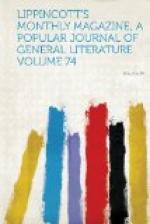[Illustration: GERMAN BUILDING.]
The commercial idea is so prominent in this, as in all expositions, that it is difficult to draw the line between public and private interest among its different features, and particularly among what may be called its outgrowths, overflowings or addenda. Here is half a square mile dotted with a picturesque assemblage of shops and factories, among which everything may be found, from a soda-fountain or a cigar-stand up to a monster brewery, all devoted at once to the exemplification and the rendering immediately profitable of some particular industry. In one ravine an ornate dairy, trim and Arcadian in its appurtenances and ministers as that of Marie Antoinette and her attendant Phillises at the Petit Trianon, offers a beverage presumably about as genuine as that of ’76, and much above the standard of to-day. A Virginia tobacco-factory checkmates that innocent tipple with “negrohead” and “navy twist.” A bakery strikes the happy medium between the liquid sustenance and the narcotic luxury by teaching Cisatlantic victims of baking-powders and salaeratus how to make Vienna bread. Recurring to fluids, we find unconquered soda popping up, or down, from innumerable fonts—how many, may be inferred from the fact that a royalty of two dollars on each spigot is estimated to place thirty-two thousand dollars in the strong box of the exposition. Nor does this measure the whole tribute expected to be offered at these dainty shrines of marble and silver. The two firms that bought the monopoly of them pay in addition the round sum of twenty thousand dollars. It speaks well for the condition of the temperance cause that beer is the nearest rival of aerated water. An octroi of three dollars per barrel is estimated to yield fifty thousand dollars, or two thousand dollars less than soda-water. Seventy-five thousand dollars is the aggregate fee of the restaurants. Of these last-named establishments, the French have two. The historic sign of the




